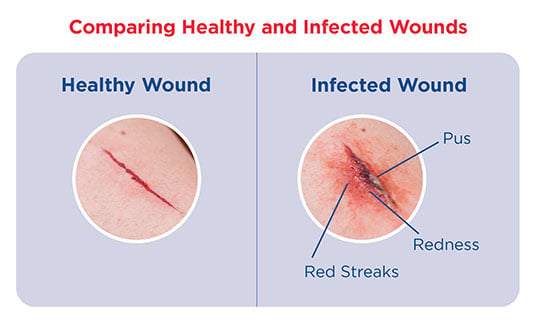CONTINUE YOUR CARE
CONTINUINING YOUR CARE
Keep up the good work with your bandage changes. It’s an important part of avoiding infections. That’s what this section is all about.

The 8 Signs of Infection4,5
As you continue caring for your wound, be on the lookout for these signs of infection, which can commonly occur during the first 30 days of recovery:
- Tenderness
- Redness
- Warm to the touch
- Swelling around the wound
- Red streaks leading from the wound
- Throbbing pain
- Pus
- Fever
TREATING AN INFECTION
If you notice any signs of infection, here are the steps to take:
- Contact your doctor. He or she will be able to assess if you need to return to the hospital or continue home treatment. He or she can also advise how to treat an infection, should you have one.
- If your doctor recommends it, you can take pain relievers such as TYLENOL® or MOTRIN®. You may be prescribed an antibiotic
NURSE TIP: Remember: Even with an infection, clean, treat, and protect the wound. Keeping up your care is essential for helping an infection go away
Preventing an Infection
Statistics show that 30% of postsurgical wounds get infected6 and may need to be treated back at the hospital. To help prevent infections, washing your hands and applying fresh, clean bandages are good practices. Make sure you’re changing your bandage at least 2x a day1, or as directed by your doctor. Cleaning and covering your wound can also help prevent infection of your wound.
APPLY an antibiotic ointment, like POLYSPORIN® Antibiotic Ointment, to help prevent infections.
References:
1. Cuts and scrapes: first aid. Mayo Clinic Web site. http://www.mayoclinic.org/first-aid/first-aid-cuts/basics/art-20056711. Accessed March 14, 2014.
4. Heisler J. Signs and symptoms of an infection: how to identify an infection after surgery. About.com Web site. http://www.surgery.about.com/od/aftersurgery/qt/ SignsInfections.htm. Accessed June 24, 2014.
5. Surgical site infections. Drugs.com Web site. http://www.drugs.com/cg/surgical-site-infections.html. Accessed March, 14, 2014.
6. Surgical site infection (SSI) event. Centers for Disease Control and Prevention Web site. http://www.cdc.gov/nhsn/pdfs/ pscmanual/9pscssicurrent.pdf. Accessed June 24, 2014.


